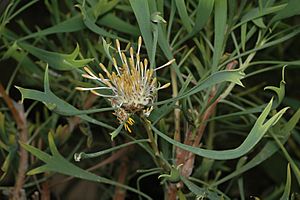Three-toothed coneflower facts for kids
Quick facts for kids Three-toothed coneflower |
|
|---|---|
 |
|
| Isopogon tridens in the ANBG | |
| Scientific classification | |
| Genus: |
Isopogon
|
| Species: |
tridens
|
| Synonyms | |
|
|
The Three-toothed coneflower, or Isopogon tridens, is a unique flowering plant. It is part of the Proteaceae family. This plant grows only in the southwest of Western Australia. It is a shrub with special wedge-shaped leaves. These leaves have two or three sharp points, like teeth. The plant also has round flower heads. These flowers are usually creamy white, but sometimes they can be purple.
Contents
What Does It Look Like?
The Three-toothed coneflower is a shrub. It usually grows to be about 1 to 1.5 meters tall. Its branches are a bit hairy and can be pale reddish or greyish-brown.
Leaves and Flowers
The leaves are shaped like a wedge. They are about 35 to 85 millimeters long. Each leaf has two or three sharp points or "teeth" near its end.
The flowers grow in round, flat heads. These heads are found at the ends of the branches. Each flower head is about 20 to 30 millimeters wide. At the bottom of the flower heads are special, hairy, egg-shaped leaves called bracts.
The flowers themselves are mostly smooth. They are creamy white, but sometimes they can be a deep purple color. Each flower is about 22 to 28 millimeters long.
When It Blooms
This plant usually blooms in June and July. After flowering, it produces a hairy seed pod. These seed pods are joined together in a flat, round head. This head is about 20 millimeters wide.
How It Got Its Name
The Three-toothed coneflower was first officially described in 1855. A scientist named Carl Meissner gave it the name Isopogon trilobus var. tridens. He wrote about it in a science journal. He studied plants collected by James Drummond.
Later, in 1868, another scientist named Ferdinand von Mueller changed its name. He renamed it to Isopogon tridens.
Where It Grows
The Three-toothed coneflower usually grows in areas with shrubs or heathland. It is found in a small part of Western Australia. This area stretches from near the Arrowsmith River to Eneabba. This region is known as the Geraldton Sandplains.
Is It Protected?
The Government of Western Australia's Department of Parks and Wildlife has looked at this plant. They have classified it as "not threatened." This means it is not currently in danger of disappearing.

